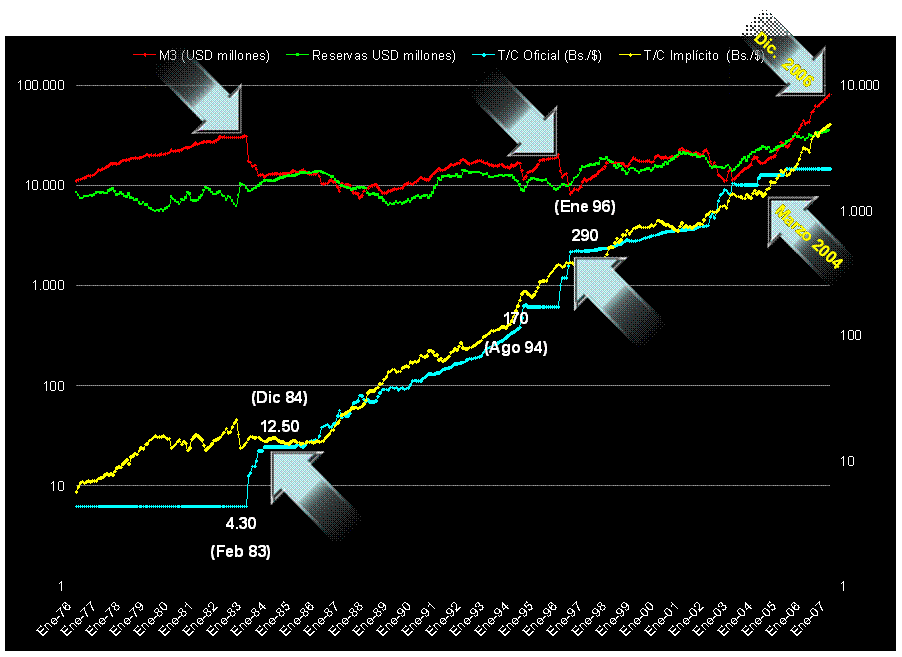That’s the question many of our clients are asking since they need to decide whether to cover their FX exposure now or wait to see if the parallel rate drops further. Sadly, the answer is: Yes, 3500 is coming back. Not only for the seasonal reasons presented in last week’s report, but mainly because this years phenomenal growth in Bolivar Monetary Mass already duplicated the amount of international reserves in Central Bank. This is the fundamental difference between this November’s 3500 and the last time the parallel market reached 3500 in March 2004.
The graph below shows the behavior of four key variables over the past 30 years: Bolivar Monetary Mass (Red) in dollar terms, International Reserves (Green), The Implicit FX rate (Yellow) and the Official FX rate (blue). The Implicit FX rate is the result of dividing Bolivar Monetary Mass into International Reserves. The theory behind this number is that the only dollars truly backing Bolivars are those available at Central Bank. Any stories you hear about FONDEM´s supposedly colossal reserves and how they must be added to Central Bank reserves in order to compute the “true” amount of reserves is bogus.
The fundamental difference between Central Bank reserves and any monies held by FONDEM is that Central Bank is constitutionally bound not to spend them, whereas FONDEM can and does what it wants with its monies. In fact, up until today no one knows how FONDEM spends its money and how much of it is still available. This crucial difference is what motivates the government to transfer Central Bank reserves to FONDEM repetitively. Hence their announcement last month that before year end another $5 to $6 billion will be taken from Central Bank reserves and transferred to FONDEM, on top of the $6 billion transferred in 2005 and the $4 billion transferred early this year.
Having cleared that concept, let’s dive into the chart. As you can see there, in March 2004, the Implicit FX rate (yellow line) was way below the Official FX rate (blue line). That meant that however high the parallel market went, it was destined to retreat down to a level consonant with the underlying stability of the monetary system. That stability was founded on the fact that Bolivar Monetary Mass (red line) was growing below the growth rate of International Reserves (green line). However, as you can see on the chart, since late 2005, Bolivar Monetary growth started exceeding the growth of International Reserves, up to the point that today the Implicit FX rate has become twice as large as the Official FX rate. The other two times this occurred is shown on the chart where the blue line was forced to converge upwards to the yellow line (1983 and 1996).
So that’s where we are at now, and this is partly the reason why this week the parallel market already went Bs. 120/$ higher than last week. In conclusion, if you compare this November’s 3500 to March 2004´s 3500, the difference is the laws of physics and every retreat will be met with an upward bounce, as economic agents recognize the underlying imbalances in monetary stocks.


Leave a Reply